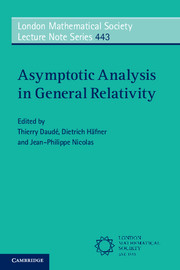Book contents
- Frontmatter
- Contents
- 1 Introduction to Modern Methods for Classical and Quantum Fields in General Relativity
- 2 Geometry of Black Hole Spacetimes
- 3 An Introduction to Conformal Geometry and Tractor Calculus, with a view to Applications in General Relativity
- 4 An Introduction to Quantum Field Theory on Curved Spacetimes
- 5 A Minicourse on Microlocal Analysis for Wave Propagation
- References
1 - Introduction to Modern Methods for Classical and Quantum Fields in General Relativity
Published online by Cambridge University Press: 21 December 2017
- Frontmatter
- Contents
- 1 Introduction to Modern Methods for Classical and Quantum Fields in General Relativity
- 2 Geometry of Black Hole Spacetimes
- 3 An Introduction to Conformal Geometry and Tractor Calculus, with a view to Applications in General Relativity
- 4 An Introduction to Quantum Field Theory on Curved Spacetimes
- 5 A Minicourse on Microlocal Analysis for Wave Propagation
- References
Summary
The last few decades have seen major developments in asymptotic analysis in the framework of general relativity, with the emergence of methods that, until recently, were not applied to curved Lorentzian geometries. This has led notably to the proof of the stability of the Kerr–de Sitter spacetime by P. Hintz and A. Vasy [17]. An essential feature of many recent works in the field is the use of dispersive estimates; they are at the core of most stability results and are also crucial for the construction of quantum states in quantum field theory, domains that have a priori little in common. Such estimates are in general obtained through geometric energy estimates (also referred to as vector field methods) or via microlocal/spectral analysis. In our minds, the two approaches should be regarded as complementary, and this is a message we hope this volume will convey succesfully. More generally than dispersive estimates, asymptotic analysis is concerned with establishing scattering-type results. Another fundamental example of such results is asymptotic completeness, which, in many cases, can be translated in terms of conformal geometry as the well-posedness of a characteristic Cauchy problem (Goursat problem) at null infinity. This has been used to develop alternative approaches to scattering theory via conformal compactifications (see for instance F. G. Friedlander [11] and L. Mason and J.-P. Nicolas [22]). The presence of symmetries in the geometrical background can be a tremendous help in proving scattering results, dispersive estimates in particular. What we mean by symmetry is generally the existence of an isometry associated with the flow of a Killing vector field, though there exists a more subtle type of symmetry, described sometimes as hidden, corresponding to the presence of Killing spinors for instance. Recently, the vector field method has been adapted to take such generalized symmetries into account by L. Andersson and P. Blue in [2].
This volume compiles notes from the eight-hour mini-courses given at the summer school on asymptotic analysis in general relativity, held at the Institut Fourier in Grenoble, France, from 16 June to 4 July 2014.
- Type
- Chapter
- Information
- Asymptotic Analysis in General Relativity , pp. 1 - 8Publisher: Cambridge University PressPrint publication year: 2018



